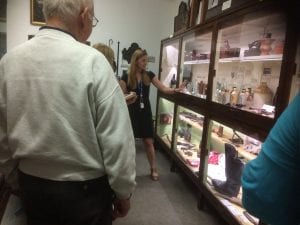
Visual Culture graduate (2013) Anne Nielsen writes about developing her career in local museums
I chose Visual Culture as my BA at Brighton because I liked the wide scope of the course. Throughout my degree I kept choosing options and essays that were related to museum studies – this surprised me because I hadn’t thought of a career in museums. The option ‘Behind the Scenes’ enabled me to do a placement in the Fine Art Department at Brighton Museum & Art Gallery, which introduced me to the practical side of museums. I stayed on as a volunteer and had the opportunity to assist with exhibitions and write interpretation labels. The experience led me to pursue a career in museums and helped me secure other opportunities in the sector.

Fig. 2 Treasures from the waistcoat collection. Costume display at Tunbridge Wells Museum & Art Gallery. Author’s photograph.
After my BA, I took a year out for travelling and working. Although I worked in retail, I kept my museum connection alive by volunteering as a gallery steward at The Holburne in Bath. This was my first introduction to visitor services, which I really enjoyed as I got to engage with a variety of visitors.
I then went on to complete a MSc in Visual, Material and Museum Anthropology at University of Oxford. I chose the course as it offered critical engagement with the origin of museums and their collections, their purpose and relationships with source communities. It also introduced me to a new discipline: anthropology, which gave me a fresh perspective on material culture and museum studies. The course was based at the Pitt Rivers Museum and some of my tutors were curators there, which offered an interesting insight into working with ethnographic collections. During my MSc I completed a paid internship in the Photographs & Manuscripts collection at the Pitt Rivers. I catalogued and digitised a collection of early 20th century photographs taken by a German geologist during expeditions in Asia. The internship developed my skills in documentation which are essential for collections management. It was also very satisfying as the digitisation and cataloguing made the collection visible and accessible.
After graduation, I got a job as Visitor Services Assistant at Tunbridge Wells Museum & Art Gallery – I was only meant to be there for three months but I’ve ended up staying for more than two years! I’ve had three jobs since I started here, and currently I’m part-time Documentation Assistant and part-time Visitor Services & Admin Officer. There is still a strong disconnect between Front of House staff and ‘Behind the Scenes’ staff in museums so my two positions allow me to bridge the gap. Working in a small museum can be incredibly rewarding as the workload can be very varied, which is perfect for developing skills in new areas. Since I started working here, I’ve been involved in exhibition installations and collections work even before I started my collections job. I’ve had the opportunity to give guided tours of the collections which has boosted my confidence in public speaking (Fig.1). Another aspect I’ve enjoyed is supervising volunteers and work experience students, as you get to pass on your passion for museums and support others in developing new skills.
One of my highlights this year has been the costume display I curated and mounted. Costume is a new subject area for me so it has been exciting to expand my knowledge and learn how to mount costume. The museum has an excellent costume collection – I chose men’s waistcoats to highlight men’s fashion and to showcase some of the treasures in the collection (Fig.2). The selected Georgian and Regency waistcoats are all highly decorative but they also illustrate changing shapes and styles. The star of the display is the silk wedding waistcoat (1743) complete with original receipt (Fig.3). The latter not only tells us who commissioned it (the bride) but also who made it (Mary Bampton) and how much she was paid (the equivalent of a month’s wages). It is extremely rare for women makers to be documented which is why it is so incredible that this receipt has survived. The wearer had very narrow shoulders which made it a challenge to mount the waistcoat. All our male mannequins were too broad so we had to be creative and use a female mannequin instead. We created a flat chest with wadding and then filled the sides and padded the upper back with wadding to mould it into a male shape (Fig.4).
The museum is about to start a big project as we have received HLF and Arts Council funding to expand and redevelop the building and galleries and integrate services. We are now gearing up towards decanting the collections to off site storage which will be my priority for the next 6 months. My future plans? I want to keep developing my expertise in collections and curation and a PhD is also on the list!


